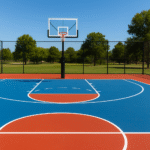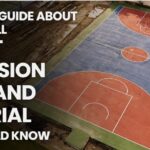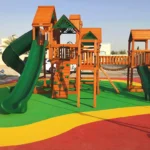Introduction to EPDM Rubber Flooring
Ever walked on a playground surface that felt soft yet tough? Chances are, you stepped on EPDM rubber flooring. Known for its durability, safety, and versatility, EPDM (Ethylene Propylene Diene Monomer) rubber has become a preferred flooring choice across industries. From sports courts to children’s play zones, its presence is everywhere.
Understanding EPDM Material
EPDM is a synthetic rubber made from ethylene, propylene, and diene monomers. Unlike natural rubber, it offers excellent resistance to weather, heat, and ozone. This makes it a long-lasting material for both indoor and outdoor applications.
Key Features of EPDM Rubber Flooring
- Slip Resistance: Minimizes accidents in gyms, playgrounds, and wet areas.
- Shock Absorption: Provides cushioning to reduce injuries from falls.
- UV & Ozone Resistance: Ideal for outdoor use without fading or cracking.
- Low Maintenance: Easy to clean with basic sweeping and mopping.
Types of EPDM Rubber Flooring
- EPDM Tiles: Perfect for modular setups, gyms, and playgrounds.
- EPDM Rolls: Great for covering large indoor areas like fitness centers.
- Poured-in-Place EPDM Flooring: Seamless, customizable, and widely used in playgrounds and sports courts.
Applications of EPDM Rubber Floor
- Sports Facilities: Running tracks, tennis courts, and multipurpose halls.
- Playgrounds: Provides a safe, cushioned surface for children.
- Gyms & Fitness Centers: Reduces impact, noise, and enhances safety.
- Industrial Areas: Withstands heavy loads and machinery.
- Residential Use: Balconies, terraces, and home gyms.
Advantages of EPDM Rubber Flooring
- Safety Benefits: Reduces risk of slips and injuries.
- Durability: Withstands harsh weather and heavy use.
- Eco-Friendly: Many EPDM floors are made from recycled materials.
- Aesthetic Appeal: Available in multiple colors and patterns.
Disadvantages of EPDM Rubber Flooring
- Initial Cost: Higher than PVC or vinyl flooring.
- Limited Chemical Resistance: Certain oils and solvents can damage EPDM.
Comparison with Other Flooring Materials
- EPDM vs. PVC: EPDM is more durable and eco-friendly.
- EPDM vs. Natural Rubber: EPDM resists weather better.
- EPDM vs. Polyurethane: EPDM offers better cushioning and longevity.
Installation Process of EPDM Rubber Flooring
Surface Preparation: Ensure clean, dry, and level base.
Installation Methods:
- Glue-down for permanent setups.
- Loose-lay for temporary areas.
- Poured-in-place for seamless applications.
Avoiding Mistakes: Improper base leveling or poor adhesive choice can reduce lifespan.
Maintenance Tips for EPDM Flooring
- Sweep or vacuum regularly.
- Mop with mild detergent.
- Avoid harsh chemicals.
- Repair minor cracks with patch kits.
Lifespan of EPDM Rubber Flooring
With proper care, EPDM flooring lasts 15–20 years, sometimes even longer in low-traffic areas. Outdoor conditions and maintenance directly affect longevity.
Cost of EPDM Rubber Flooring
- Average cost: ₹200–₹500 per sq. ft. (depending on type and thickness).
- Though initial investment is higher, its long lifespan makes it cost-effective.
Top Industries and Users of EPDM Floor
- Education: Schools and universities.
- Healthcare: Hospitals and rehabilitation centers.
- Corporate: Offices and recreational areas.
- Public Infrastructure: Parks, playgrounds, and community gyms.
Sustainability of EPDM Rubber Flooring
EPDM flooring contributes to green building certifications. It’s recyclable, energy-efficient, and often made using post-consumer recycled rubber.
Future of EPDM Rubber Floor
Expect to see EPDM with smarter designs, eco-friendly manufacturing, and hybrid blends to further improve performance and sustainability.
Conclusion
EPDM rubber flooring is more than just a surface—it’s a combination of safety, durability, and sustainability. Whether you’re designing a playground, gym, or industrial space, EPDM provides the perfect balance of performance and aesthetics. Investing in it today ensures years of reliable service and peace of mind.
FAQs
Q1. What makes EPDM rubber flooring different from normal rubber flooring?
EPDM is more durable, weather-resistant, and UV-stable compared to natural rubber.
Q2. Can EPDM flooring be used outdoors?
Yes, it’s designed to withstand sunlight, rain, and temperature fluctuations.
Q3. Is EPDM rubber flooring safe for children?
Absolutely. Its shock-absorbing properties make it perfect for playgrounds.
Q4. How long does EPDM flooring last?
On average, 15–20 years with proper maintenance.
Q5. Is EPDM flooring eco-friendly?
Yes, many EPDM products are recyclable and contribute to sustainable building practices.




